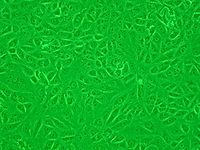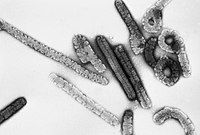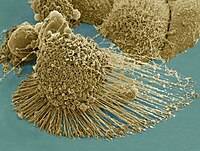
From functional genomics of vero cells to CRISPR‐based genomic deletion for improved viral production rates
Sign Up to like & getrecommendations! Published in 2022 at "Biotechnology and Bioengineering"
DOI: 10.1002/bit.28190
Abstract: Despite their wide use in the vaccine manufacturing field for over 40 years, one of the main limitations to recent efforts to develop Vero cells as high‐throughput vaccine manufacturing platforms is the lack of understanding… read more here.
Keywords: vero; vero cells; genomic deletion; gene ... See more keywords

Comparative analysis of the biological characteristics of three CV‐A10 clones adaptively cultured on Vero cells
Sign Up to like & getrecommendations! Published in 2022 at "Journal of Medical Virology"
DOI: 10.1002/jmv.27796
Abstract: Coxsackievirus A10 (CV‐A10) is a major pathogen that causes hand, foot, and mouth disease. There are no effective therapeutic drugs for CV‐A10 infection; therefore, CV‐A10 vaccines should be developed. Previously, we isolated a CV‐A10 strain… read more here.
Keywords: comparative analysis; cultured vero; vero cells; amino acid ... See more keywords

Ultrastructural analysis of monkeypox virus replication in Vero cells
Sign Up to like & getrecommendations! Published in 2023 at "Journal of Medical Virology"
DOI: 10.1002/jmv.28536
Abstract: In early May 2022, the first worldwide monkeypox virus (MPXV) outbreak was reported, with different clinical aspects from previously studied human monkeypox infections. Despite monkeypox medical importance, much of its biological aspects remain to be… read more here.
Keywords: replication; vero cells; analysis; monkeypox virus ... See more keywords

Resveratrol inhibits the replication of severe acute respiratory syndrome coronavirus 2 (SARS‐CoV‐2) in cultured Vero cells
Sign Up to like & getrecommendations! Published in 2020 at "Phytotherapy Research"
DOI: 10.1002/ptr.6916
Abstract: Dear Editor, An emergence of the novel coronavirus designated as the severe acute respiratory syndrome coronavirus 2 (SARS-CoV-2) at the end of 2019 has triggered an ongoing pandemic of coronavirus disease 2019 (COVID-19) globally. As… read more here.
Keywords: vero cells; infection; sars cov; replication ... See more keywords

Size-dependent cellular uptake mechanism and cytotoxicity toward calcium oxalate on Vero cells
Sign Up to like & getrecommendations! Published in 2017 at "Scientific Reports"
DOI: 10.1038/srep41949
Abstract: Urinary crystals with various sizes are present in healthy individuals and patients with kidney stone; however, the cellular uptake mechanism of calcium oxalate of various sizes has not been elucidated. This study aims to compare… read more here.
Keywords: vero cells; calcium oxalate; uptake mechanism; cellular uptake ... See more keywords

ACE2 Affects the Expression and Function of IFITM3 During SARS-CoV-2 Pseudovirus Infection in Vero E6 Cells.
Sign Up to like & getrecommendations! Published in 2022 at "Viral immunology"
DOI: 10.1089/vim.2022.0042
Abstract: COVID-19 is a globally infectious viral epidemic of great public health concern caused by severe acute respiratory syndrome coronavirus 2 (SARS-CoV-2). Angiotensin-converting enzyme 2 (ACE2) plays its role as the receptor for SARS-CoV-2 through binding… read more here.
Keywords: infection; vero cells; expression; ifitm3 ... See more keywords

Non‐hemolytic enterotoxin of Bacillus cereus induces apoptosis in Vero cells
Sign Up to like & getrecommendations! Published in 2017 at "Cellular Microbiology"
DOI: 10.1111/cmi.12684
Abstract: Bacillus cereus is an opportunistic pathogen that often causes foodborne infectious diseases and food poisoning. Non‐hemolytic enterotoxin (Nhe) is the major toxin found in almost all enteropathogenic B. cereus and B. thuringiensis isolates. However, little… read more here.
Keywords: non hemolytic; apoptosis vero; hemolytic enterotoxin; bacillus cereus ... See more keywords

Inhibition of chikungunya virus replication by N-ω-Chloroacetyl-L-Ornithine in C6/36, Vero cells and human fibroblast BJ
Sign Up to like & getrecommendations! Published in 2023 at "Antiviral Therapy"
DOI: 10.1177/13596535231155263
Abstract: Background Polyamines are involved in several cellular processes and inhibiting their synthesis affects chikungunya virus (CHIKV) replication and translation, and, therefore, reduces the quantity of infectious viral particles produced. In this study, we evaluated the… read more here.
Keywords: human fibroblast; replication; vero cells; chikv replication ... See more keywords

Angiotensin II Receptor Blockers (ARBs Antihypertensive Agents) Increase Replication of SARS-CoV-2 in Vero E6 Cells
Sign Up to like & getrecommendations! Published in 2021 at "Frontiers in Cellular and Infection Microbiology"
DOI: 10.3389/fcimb.2021.639177
Abstract: Several comorbidities, including hypertension, have been associated with an increased risk of developing severe disease during SARS-CoV-2 infection. Angiotensin II receptor blockers (ARBs) are currently some of the most widely-used drugs to control blood pressure… read more here.
Keywords: receptor blockers; vero cells; angiotensin receptor; receptor ... See more keywords

Moringa oleifera Hot Water Extract Protects Vero Cells from Hydrogen Peroxide-Induced Oxidative Stress by Regulating Mitochondria-Mediated Apoptotic Pathway and Nrf2/HO-1 Signaling
Sign Up to like & getrecommendations! Published in 2022 at "Foods"
DOI: 10.3390/foods11030420
Abstract: The present study discloses the identification of phenolic compounds in Moringa oleifera hot water extract (MOH) and the evaluation of its antioxidant activity on H2O2-induced oxidative stress in Vero cells. Upon analysis, MOH was found… read more here.
Keywords: water extract; oleifera hot; moringa oleifera; vero ... See more keywords

A Sulfated Abalone Polysaccharide Inhibited SARS-CoV-2 Infection of Vero E6 Cells In Vitro
Sign Up to like & getrecommendations! Published in 2022 at "Foods"
DOI: 10.3390/foods11182865
Abstract: Sulfate polysaccharides, such as heparin sulfate, have been found to have inhibitory activity against SARS-CoV-2. An abalone polysaccharide, AGSP, was deeply sulfate modified using the chlorosulfonic acid/pyridine method, yielding S-AGSP. AGSP and S-AGSP inhibitions of… read more here.
Keywords: infection vero; agsp; vero cells; cov infection ... See more keywords